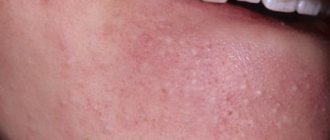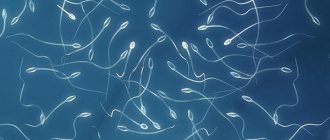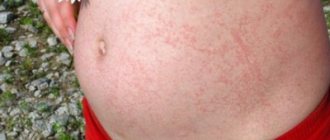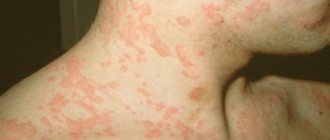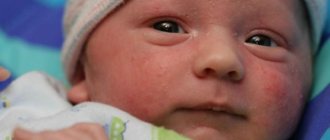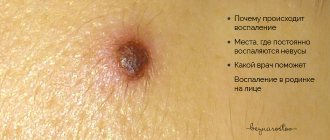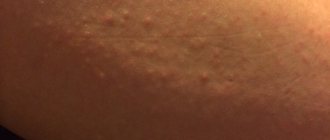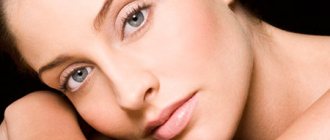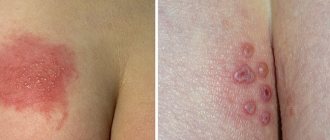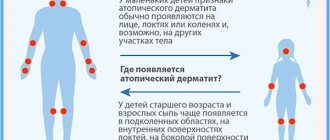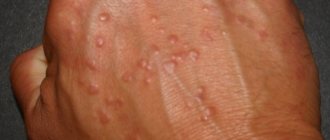Typology of allergic rashes
The issue of primary recognition of an allergic rash is within the competence of a dermatologist or allergist.
These specialists must distinguish between infectious, vascular, autoimmune and allergic rashes. Then the treatment prescribed according to the indications can help get rid of the morphological elements of rashes and skin itching.
Allergic skin rash presents as urticaria or erythema. They develop in response to an allergen entering the body or its local contact with the patient’s skin.
Urticaria is a limited, hyperemic area of rash with smooth edges. However, on the surface of the rash there are numerous tubercles measuring 2.5-4 mm. In appearance, such a rash resembles a burn from a nettle leaf.
Erythema is another type of rash that occurs as a symptom in a number of allergic diseases.
Most often, erythema is a sign of atopic dermatitis, neurodermatitis, and contact dermatitis.
Most often, erythema manifests itself as a reaction of the body to local exposure to an allergen: detergent, cosmetic compositions and other substances.
FAQ
Does allergies cause fever or not?
A slight increase in temperature when an allergic component enters the body can be considered normal. Thus, a signal is given that a foreign object has penetrated the cells. A change in temperature of more than one degree should be considered a much more alarming symptom. This indicates the addition of inflammation, and therefore in this case a separate recovery course is prescribed.
What is the name of the allergy blood test?
A blood test for allergies is a test of the blood for the content of immunoglobulin E. Depending on the specific food or other allergens, different indices of this component are identified.
What to apply to an allergic rash?
To ensure effective treatment of allergic rashes, the following remedies are used:
- non-hormonal ointments, for example, Fenistil or Bepanten;
- hormonal compounds, namely Advantan or Elokom;
- Fluorocort, Afloderm and others, used for significant allergic and inflammatory reactions.
The most potent components are Galcinonide and Dermovate ointments, the use of which would be best discussed with a specialist. In addition, treatment of skin allergies in adults can be carried out using Levomekoli, Panthenol and other agents that are more likely to be preventive.
Can you be allergic to coffee?
Instant or brewed coffee is a fairly strong allergen. In the vast majority of cases, the reaction manifests itself in vomiting, severe abdominal pain and frustration. Less commonly, skin changes such as rash or itching may occur. The most rare symptoms are an increase in temperature, as well as Quincke's edema.
How to find out what an adult is allergic to?
To determine a specific allergen, specialized tests are used to identify even the rarest species. In the vast majority of cases, skin tests or blood tests for immunoglobulin E are used. It is recommended to use them all together, which will increase the accuracy of the studies, for example, if a reaction to mascara or shellac is formed.
What could you be allergic to in October?
Allergies in mid-autumn, namely in October, can develop due to three factors
When talking about this, people pay attention to pollen, fungal spores and house dust. It should be borne in mind that it is in October that quinoa, wormwood and ragweed bloom, as a result of interaction with which a rash, swelling of the throat and no less serious symptoms can occur
Some of them are directly related to how a sweet allergy manifests itself.
Allergy to milk, is it possible to have fermented milk products?
Fermented milk products can also not be consumed by everyone, because, for example, cow’s milk contains at least 20 components that have different protein natures. Lipoproteins and alpha-lactalbumin deserve special attention in this regard. This is why if an adult begins to sneeze or cough after eating dairy products, it is recommended that they undergo a special check.
Allergy to hair dye, what to do?
If burning and itching occurs in the face or neck, the affected area of skin is lubricated with compounds such as Fenistil-gel or Psilo balm. Antihistamines are used if a person's condition quickly worsens or if they begin to itch excessively. If symptoms and fever do not go away within several hours, it is recommended to seek medical support.
We recommend reading
Ring-shaped erythema in children and adults
The soles of the feet are covered with red spots
Where does strophulus come from on a child’s skin?
Real causes of facial swelling and treatment methods
7+ unusual signs of allergies that can be confused with symptoms of other diseases
- 10 talented teenagers who can outshine adult scientists
- 19 photos proving that there is no safer place than next to your mother
- I moved to France and will tell you about the secrets that help locals live to the fullest
- What members of the British royal family looked like in their youth (Some are simply unrecognizable)
- 25 absurd situations that could only happen in Japan
- 15 adoption stories that prove our world is a great place
- 15 chic tattoo ideas for those who always can’t decide on a design
- 10+ stories about how men are masters at getting into trouble
- 12 things that seemed cool to us in 2010, but in 2020 they only make us smile
- 17 proofs that aliens arriving on our earth will have something to surprise
- The authors of AdMe.ru tested popular face fitness exercises on themselves. And they told us about the results without embellishment
- 13 actions of others that will make even those whose calmness is the size of Everest nervous
- 23 characters from fairy tales and cartoons, whose real age most people don’t even know
- 17 pairs of animals that nature made as similar to each other as two peas in a pod
- What do the people from whom world-famous sculptures were sculpted look like?
- 17 animals that nature did not fantasize about for a long time, but simply created them in someone else’s likeness
Body rash: causes
An allergic rash on the body appears in many situations. You need to understand that the disease in this case can manifest itself unpredictably. In this case, the rash spreads throughout the body in the shortest possible time. A person may complain of itching and burning. Initially, the inflamed areas may become wet. Subsequently, a crust appears on them, which can peel off. Typically, such unpleasant symptoms result from the inclusion of allergic foods in the diet. What foods are immune system irritants?
Such products, first of all, are dangerous for children who have not yet gotten used to a regular meal. In order to eliminate the risk of such a disease occurring in the future, harmful foods should be excluded from the diet. It is recommended to take medications that can successfully combat allergic reactions. In addition, the rash may be caused by hypersensitivity to pollen from certain plants. In this case, the maximum risk occurs in the spring. Such people should take certain medications for preventive purposes. Allergy - a rash all over the body - is an unpleasant manifestation of the disease. In addition, the disease is accompanied by additional symptoms, namely general weakness, swelling of the eyes, high fever, and loss of appetite. Each of the above signs of the disease leads to a serious deterioration in the quality of life, so it is recommended to start the treatment course as early as possible.
Features of treatment of rashes on the body
First of all, you should contact an experienced immunologist. You can do a test that will allow you to make an accurate diagnosis. After this, it will be possible to determine what treatment should be. Skin tests will allow you to understand the characteristics of the human body’s reaction to allergens. You should refuse to engage in self-treatment if the causes of the disease continue to remain unknown. Symptoms such as itching, redness of the skin, rash are a painful reaction to incoming substances, but they can only be eliminated in one case, namely by understanding the causes of the disease, identifying allergens and refusing contact with them, and effective treatment. At the same time, it becomes possible to stop the clinical picture of the disease in the shortest possible time and achieve long-term remission.
Causes
An allergen is almost always a molecular structure of protein origin. Not all allergens cause an immune response when they enter the body. Some are able to bind to proteins that are found in all human tissues. Usually these are elements that are found in medications or chemicals.
After the first entry into the child’s body, the allergen causes sensitization, during which the sensitivity and susceptibility of histamine receptors increases, and sensitivity increases specifically to a specific allergen. Subsequent contacts with this allergen are accompanied by a whole cascade of immune processes with the formation of skin rashes.
The non-immune mechanism is associated with the release of histamines, which, when exposed to immune cells, cause swelling of the skin layers, dilation of capillaries (cause of redness), and blistering.
The number of children suffering from skin allergies is growing every year. Doctors believe that the main reasons lie in the deterioration of the environment and the consumption of genetically modified foods. In addition, doctors say that children at risk are most susceptible to allergic rashes.
It includes:
- Babies born from a pregnancy accompanied by pathologies (preeclampsia, oligohydramnios or polyhydramnios, carrying twins or triplets, threatened miscarriage, severe toxicosis at the beginning and end of gestation).
- Children who at an early age (up to one year) suffered severe viral infections.
- Children who, by coincidence, are transferred to artificial formula from birth or from the age of 3 months.
- Babies who lack important vitamins, as well as those who are undernourished or malnourished.
- Children who were forced to take medications for a long time.
How to Treat Skin Rash Naturally
Skin rashes can be the result of many human diseases and pathological conditions, ranging from allergies to infections. In this article, we'll look at how to treat skin rashes based on the most common causes, especially allergic rashes.
Allergic skin rashes can be divided into two categories:
- Skin. Skin allergies are caused by direct contact with an allergen.
- System. Systemic allergies can be caused by something entering the digestive tract.
Systemic allergies can be more severe and can be more difficult to diagnose. If you suspect a food allergy, first check your body's reaction to eggs, milk, seafood, soy, wheat, tree nuts and peanuts.
The skin rash can be localized to a specific area or widespread across the surface of the skin, even to a rash all over the body. Skin rashes may include itching, tingling, burning and heat, pain, lumps or blisters, or the rash may appear without any discomfort.
Sometimes the rash may go away on its own after the allergen has stopped affecting you. But there are many cases of allergic rashes that require treatment. Skin rashes can occur with changes in temperature, as a result of ingestion of food allergens, due to increased sensitivity to certain drugs. Irritation and rashes on the skin can also appear when inhaling pollen, dust, smoke, when soap products, perfumes, lotions come into contact with the skin, or when coming into contact with latex and rubber.
How and how to effectively treat skin rashes
There are several effective natural remedies that can be used to treat skin rashes:
- Chamomile decoction lotions (applied topically on the skin surface).
- Applying olive oil to the affected areas of the skin.
- A mixture of cod liver oil and vitamin E is very effective in eliminating skin rashes (when taken orally).
- A prepared mixture of crushed basil leaves combined with 1 tablespoon of olive oil, 2 cloves of garlic. A pinch of salt and a pinch of pepper should be spread on the affected skin.
- Taking an oatmeal bath is one of the best ways to treat skin rashes. Pour one glass of raw oatmeal into your bath and soak there for a while.
- Another extremely effective treatment is to apply pureed almond leaves to the affected area.
- Vitamin C has strong antioxidant properties that can help heal rashes and reduce the likelihood of subsequent allergic reactions.
- Natural apple cider vinegar and fresh honey are very effective in eliminating allergies. Add half a tablespoon each of apple cider vinegar and honey to a glass of water and drink the resulting drink three times a day.
- For allergic skin rashes, you can also crush one tablespoon of poppy seeds, mix with one teaspoon of water and one teaspoon of lime juice and apply the resulting mixture to the rash.
Toxic liver damage may also be the cause of some skin rashes. In this case, it is necessary to do a liver cleanse. Herbs that help detoxify the liver include turmeric, milk thistle, and dandelion.
One product that can help avoid allergies caused by inhaling pollen from native plants and flowers is natural honey. If you often suffer from allergic skin rashes, you need to quit smoking (if you smoke, of course), reduce your alcohol intake and reduce the amount of cosmetics you wear.
Treating skin rashes with natural remedies is much safer than using most traditional, synthetic remedies such as lotions, steroids and antihistamines. In many cases of skin rashes, natural remedies are even more effective.
Duration of treatment for contact dermatitis
The cause of contact dermatitis is the direct impact of allergens on the skin. The affected area exhibits redness, swelling, and the formation of weeping, itchy blisters. Treatment begins with the exclusion of external irritants, taking antihistamines, and applying ointments with corticosteroids.
How quickly does a rash with contact dermatitis go away in a child and an adult?
The use of hormonal drugs speeds up recovery. Skin manifestations can last for several hours or 1–2 weeks, after which they begin to dry out and form crusts.
Intense itching of the skin can lead to scratching...
Prevention
To protect yourself from allergies, you need to be careful when choosing cosmetics and household chemicals. Try new products literally in “drip” portions
When prescribing medications, carefully read the instructions and supplement treatment with antihistamines and probiotics.
The diet must include:
- fiber in the form of porridges;
- fresh fruits and vegetables;
- dairy products.
When purchasing detergents, the choice should be given to the children's series. It is necessary to refuse clothes made from synthetic fabrics.
When cosmetics or detergents expire, everything should be thrown away without pity, even if there is still enough product in the package.
Allergy is a rather dangerous condition. It is possible to prevent it if you are attentive to your own health and do not come into contact with the allergen. At the slightest suspicion of an allergic reaction, an antihistamine should be placed under the tongue.
Main allergens
Allergy rash on the body, runny nose, itching, cough, conjunctivitis are the main clinical manifestations of an allergic reaction caused by contact with an allergen.
The following groups of allergens can be distinguished:
- food - honey, nuts, eggs, fish, some fruits, berries and vegetables, starch are the main causes of the development of this type of allergy, but in principle, food allergies can develop to any food;
- allergens of animal origin – fluff, feathers, wool, microparticles of saliva and other biological fluids of animals;
- medicinal - most often an allergic reaction occurs to antibiotics, painkillers for local anesthesia, hormonal agents, vaccines and serums; drugs of other groups can also cause the disease;
- professional - contact with this group of allergens is associated with human professional activity (building materials, paints and varnishes, disinfectants, talc in disposable gloves, latex);
- allergens of plant origin - plant pollen, touching leaves, flowers or branches to the skin can also cause itching and rashes like urticaria;
- insect poison - wasps, bees, ants (some people develop a hypersensitivity reaction with skin manifestations to mosquito bites);
- household allergens - dust, chemicals used in cleaning, dishwashing or laundry, air fresheners, cosmetics (including soap);
- natural factors causing the development of an allergic reaction - allergies to exposure to sunlight, high temperatures or cold are very rare.
In addition, metals (nickel, cobalt, gold), plastics (acrylic), and fabrics (especially those made of natural wool or silk) are allergens for some people.
One can also highlight pregnancy allergies, which arise as a result of hormonal imbalances in the body of the expectant mother.
Photo: Severe rash on back
Allergic rash in children
In children, an allergic rash most often appears for the first time on a diaper, baby cream, powder, washing powder, etc. This happens most often due to the immaturity of the child’s immune system, but such a reaction weakens slightly by the first year of life, and completely disappears by the age of 3-4. This rash is called “allergic dermatitis”. Then the child may develop an allergic rash to an untimely introduced product (usually with the first complementary foods). To prevent this from happening, it is necessary to introduce the first complementary foods by 4 months if the child is bottle-fed, and by 6-7 months if the baby is breastfed.
in the form of a rash most often appear in the face (on the cheeks, around the mouth), in the anus. Food allergens can be meat products, fruits, berries, chocolate, milk, eggs, etc. eaten the day before. It is very easy to identify an allergen, since the body’s reaction to it will manifest itself over the next few hours. Having seen such a manifestation of the child’s body to any product, it is necessary to exclude it from the baby’s diet for a certain period of time, and then try again to give it in small quantities.
Allergy rashes resulting from a congenital blood disease (hemophilia) appear on the body in the form of small spots - bruises, which arise as a result of a blood clotting disorder. This disease is quite serious and requires special monitoring and treatment.
An infectious rash in a child necessarily manifests itself in the form of fever, cough, pain in the throat, etc. The most common disease that is accompanied by an allergic rash is chickenpox. Many preschool children suffer from it, especially those who attend kindergarten. The infection is transmitted very quickly, as a result of which one child can infect a whole group of children in a chain. The disease, if the baby has normal immunity, is not dangerous, can be easily treated, and, most importantly, the body subsequently develops a strong immunity to such infections.
The child’s genetic predisposition to allergies also plays an important role, and the source of the allergy can be not one, but several allergens. Severe pregnancy, taking antibiotics or hormonal drugs can also cause an allergic reaction in the child. In severe cases, a baby may be born with a severe form of allergy, in which almost every product will cause a negative reaction from the body in the form of a rash and other unpleasant symptoms. Unfortunately, this type of allergy is practically not corrected, and the child is forced to eat only a limited list of foods throughout his life.
Often the cause of rashes in children is insect bites (bees, mosquitoes, spiders, etc.). How does an allergy caused by an insect bite manifest on the body?
First, a red, convex spot appears at the site of the bite, similar to a boil, only without pus. Such a rash necessarily causes itching in the child, as a result of which he begins to scratch the pimple that appears, dispersing the substance that came with the bite - poison - through the blood. As a result, even more rashes appear on the baby’s body, which itches and bothers him. You can prevent insect bites with the help of special sprays and ointments that are suitable for the child’s age. If a rash appears, you must give your baby an antihistamine (Diazolin, for example), and if the rash is accompanied by other symptoms such as fever, lethargy of the baby, or swelling on the face and body, you should immediately consult a doctor.
Allergy rashes can occur after taking certain medications. In this case, the child is shown an allergic reaction test, when a small dose of a drug to which he may be allergic is injected under the baby’s skin. Usually the drug or its component is included in the child’s medical record so that in the future this drug will not be used in treatment to avoid allergies.
Reasons for an allergic reaction
At the present time, no one can answer the question of how many varieties of allergens there are in nature. Their number is growing significantly every year.
Factors that can lead to dermatological signs of allergies include:
- some types of food products, components;
- cosmetics and perfumes;
- natural irritants (insect bite);
- use of medications;
- effect of synthetics, etc.
- First of all, the true cause of an allergic reaction can be easily identified using laboratory tests.
Classification of skin allergies
The patient's reaction is determined by scabies, redness or swelling. This group of symptoms is the same for all dermatological rashes. But there are some differences, thanks to which the cause of the disease can be accurately diagnosed.
Contact dermatitis
Symptoms of this type of allergy are observed in the case of systematic skin contact with an external or internal irritant. Signs of the disease are a reddened rash, itching, and the formation of watery papules. A clearer picture can be seen in the photo of what an allergy looks like on the skin.
At the stage of development of papules, treatment may not be carried out, since they burst on their own, and a scab remains in their place. If the illness lasts more than 7 days, you will need the help of a doctor.
- The disease is especially dangerous when it is close to the mucous membrane of the eyes and oral cavity.
Hives
This reaction can appear anywhere on the body. The rash is similar to a nettle burn. In their place, redness appears, accompanied by increased itching. The reasons may vary: cold weather, stress, exposure to ultraviolet radiation, etc.
Treatment is carried out until the body is completely restored. A reaction to allergens can begin and end instantly, with the exception of chronic urticaria.
Eczema
The first signs of a skin allergy are characterized by the appearance of reddish spots on the body. They can join together to form plaques. Over time, exacerbations or attenuation of the process may be observed.
The disease manifests itself mainly on the skin layer of the elbows, neck, and cheeks. Over time it goes away on its own. Severe cases of the disease are recommended to be carried out on the recommendation of a doctor. As a rule, the doctor prescribes antibiotics.
Foods that cause reactions
The disease can be triggered by various factors. For example, a person suddenly develops symptoms after eating food with an increased allergenic index.
Such foods include: eggs, country milk, wheat products, honey, oranges, chocolate products. An older person may develop a red rash on seafood products; or some types of fruits and berries.
Allergists point out that excessive sensitivity of the body often manifests itself in sauces, pastries or sausages. Allergies are much more common in childhood. With age, the digestive system improves its functioning, so much fewer cases have been recorded.
Diagnosis of skin allergies
The disease is difficult to identify on your own. But, knowing the symptoms of allergies, it is possible to identify it in the early stages of development.
When examining the patient, the doctor collects anamnesis and prescribes additional diagnostics:
- blood test for immunoglobulin E content;
- allergen tests;
- clinical blood test with formula.
People often mistake allergies for an infectious or viral disease. Signs of allergies are varied. At the same time, itching and sneezing, coughing and swelling may predominate.
Therapeutic measures
Drug treatment for skin allergies is carried out in stages.
Taking antihistamines
Initially, to eliminate the signs caused by allergies, the doctor prescribes antihistamines. Treatment should be carried out strictly according to medical advice, since the dosage of the drug consumed is important.
The best remedies for skin allergies are Suprastin and Tavegil. But it is worth considering that such drugs can cause side effects: drowsiness, swelling, etc. In this regard, they are advised to be taken for a short period of time and at night.
Treatment of skin allergies in children is carried out using Cetirizine. The medicine is in demand as it is suitable for children aged 6 months and older. Treatment can also be carried out with second-generation agents (Claritin, Loratadine, Zyrtec, etc.).
Corticosteroids
Hormonal antiallergic medications produced in tablets can eliminate swelling and recurrent signs of the disease in a short time.
External means
Dermatological diseases can be cured using external remedies. In order to achieve a therapeutic effect, the product is applied to the surface layer of diseased skin.
The therapeutic effect of the drugs is aimed at reducing vascular permeability. As a result, swelling is reduced and scabies is eliminated.
- Preparations for external use in the form of gels or ointments are recommended for long-term use.
An allergic reaction resulting from an insect bite is remarkably eliminated by Fenistil. Thanks to its healing properties, the patient’s swelling quickly subsides.
Thus, an allergic reaction on the skin can cause various symptoms. You should not delay treatment, because the protracted development of the disease can develop into a more complex picture. Treatment should be carried out strictly according to the doctor’s recommendation, observing the dosages of the drugs consumed.
Photo of skin allergies
- We also recommend:
Allergic rash in children
An allergic rash in a child often occurs as a result of an allergy to various medications. An important sign that allows you to distinguish allergic rashes from infectious ones is the fairly good general condition of the baby. Due to constantly disturbing itching, the child may, of course, be extremely irritable, but he does not experience an increase in temperature, loss of appetite, or drowsiness.
What actions should be taken if a child has an allergic rash?
If your baby develops an allergic rash, you need to make sure that his health is not impaired, he is breathing freely and his body temperature remains within normal limits. After this, you should remember what new dishes were introduced into his diet in recent days or hours, what washing powder was used to wash his things, and whether any medications have been used recently. If before this the baby was already prone to developing allergic manifestations, it is necessary to limit the child’s skin from contact with various chemicals as much as possible and minimize the use of baby creams, soaps and cosmetics. Soap should be used with a neutral moisturizing effect on the skin, and it should only be purchased at a pharmacy.
If all the efforts made do not lead to the desired positive result, be sure to use antihistamine creams and/or tablets on the recommendation of a doctor.
To one degree or another, various allergic manifestations are observed in about 60% of all children, so the primary task of all parents is to prevent the further development of allergies, which, if appropriate treatment is not carried out, often transforms into such serious diseases as hay fever, asthmatic dermatitis and
Symptoms and localization
The location of the rash depends on the type of allergic reaction. Contact dermatitis manifests itself as rashes in the area of influence of the irritant. For example, if the reaction occurs after hand washing, the rash will be located on the hands and palms.
With food allergies, the rashes are localized on the face. The cheeks and area around the lips are usually affected. The rash is accompanied by redness, dryness, and cracks may appear.
Externally, it is difficult to distinguish an allergic rash from dermatological diseases. Even an experienced doctor will need test results to verify the reasons for the deviation. This is explained by the variability of skin manifestations of allergies.
Allergies are indicated by:
- large blisters filled with transparent contents;
- small white bubbles;
- reddish nodules;
- swelling of the skin;
- local redness of the epidermis.
Eczema is also a type of allergic reaction. It manifests itself at the site of contact with the irritant and represents redness and peeling of the epidermis. Ulcers and erosions may appear in places where scratching occurs.
An allergic skin reaction is accompanied by general symptoms - malaise, fever, loss of strength. If large areas of skin or the entire body are affected, consult a doctor. Self-medication is dangerous to health.
Symptoms
General and local symptoms can be distinguished, as well as manifestations from the organs of vision and the respiratory system.
Local symptoms
These include:
- rashes;
- spots and plaques;
- acne;
- itching;
- burning;
- swelling and hyperemia (redness) of the skin.
Photo: Reaction to a metal plaque
General symptoms
In severe cases of an allergic reaction, the following general symptoms of the disease may appear:
- increased body temperature;
- fever and chills;
- weakness;
- irritability or decreased responsiveness;
- pale skin;
- a sharp decrease in blood pressure.
Such symptoms may appear with the development of Quincke's edema or anaphylactic shock; if they occur, you must call an ambulance.
Manifestations from the organs of vision and respiratory system
Local symptoms may include:
- allergic rhinitis;
- cough;
- conjunctivitis;
- development of shortness of breath or even an attack of bronchial asthma;
- sore throat;
- hoarseness of voice;
- feeling of sand in the eyes.
Find out modern ways to treat lip allergies. How does an allergy to wormwood manifest? What to do? Read here.
Diagnostics
Diagnosis of nettle fever occurs in several stages. A visual examination and history taking are performed.
If the cause of the disease is difficult to identify, diagnostic tests are prescribed:
- to food allergens. In this case, a potato-rice diet is prescribed to exclude allergies to the most common foods.
- physical provocative tests for heat, cold, tension, pressure.
- studies for atopy: house dust, plant pollen, animal hair.
The patient should keep a food diary in which he notes which foods and in what quantities he consumed.
In this case, an elimination diet is prescribed, and foods that can provoke the disease are excluded from the patient’s menu one by one, and a general assessment of the condition is carried out.
In some cases, treatment for urticaria allergies may take a long period. For this, both medicines and traditional methods are used.
In order to get rid of this type of allergy, products are used for external and internal use.
Drugs
When treating endogenous urticaria, it is necessary to eliminate the underlying disease that provokes the symptom.
For this purpose, medications of different groups are prescribed:
- for liver diseases, sorbents and hepaprotectors are prescribed;
- if the symptom is a consequence of gout - drugs that remove urea and non-steroidal anti-inflammatory drugs;
- for diabetes mellitus - antidiabetic drugs;
- if the disease is provoked by worms or protozoan microorganisms, then antiprotozoal and anthelmintic drugs are prescribed.
For nettle fever, intravenous administration of Calcium Chloride or Sodium Thiosulfate is indicated, which helps remove the allergen from the body.
In severe forms of the disease, corticosteroid therapy is indicated. These drugs include Prednisolone or Dexamethasone.
Pathogenetic therapy is also carried out in parallel, antihistamines of the first second and third generation are prescribed:
- Diazolin, Suprastin, Tavegil, Fenkarol, Diphenhydramine. They act for a short time and cause drowsiness.
- Loratadine, Cetirizine, Fenistil. The action is longer, taken once a day, and does not cause drowsiness.
- Astemizole, Erius, Telfast, Tigofast. They act for a long time and have a minimum of side effects.
For Quincke's edema accompanied by laryngeal edema, the following is prescribed:
- subcutaneous Adrenaline;
- intravenous Prednisolone;
- intramuscular Tavegil or Suprastin.
Subsequently, the body is cleansed with the help of sorbents, calcium supplements and antihistamine therapy is carried out.
If necessary, intravenous drip administration of infusion solutions is indicated: Reamberin, Sodium chloride, Neohemodez. For chronic recurrent urticaria, the hormonal drug Prednisolone in tablets is prescribed for a course of up to one and a half months according to the scheme, in combination with antihistamines.
When can you use allergy pills that do not cause drowsiness? The answer is here.
Traditional methods
To treat nettle fever, decoctions and infusions of herbs are used to help relieve itching and get rid of rashes.
Baths with string and chamomile are effective:
- raw materials should be mixed in equal proportions;
- Place a glass of herbal mixture in a gauze napkin;
- tie and pour three liters of boiling water;
- after it has infused for six hours, the infusion is poured into a bath one-third filled with water.
If the rash is localized, the squeezed raw materials can be used for compresses, which are applied for twenty minutes.
You can take a decoction of the herb orally, for this, add a tablespoon of herb, pour half a liter of hot water and boil for five minutes. After an hour, the infusion should be strained and drunk throughout the day.
Types of hives allergies
There are the following types of urticaria:
Acute urticaria develops as an allergic reaction to medications, foods, viruses or insect bites.
Most often it occurs on the skin of the extremities and torso and is accompanied by severe itching, which intensifies in warmth and hyperemia that occurs 15-20 minutes after contact with the allergen.
Acute urticaria begins suddenly, and the rash can disappear just as quickly, leaving virtually no traces.
Giant form or acute limited angioedema
Nettle fever or Quincke's edema is an allergic reaction of the body to any irritant.
It manifests itself in the form of blisters, which can reach large sizes.
Most often observed on the face in the area of the lips, eyes or mucous membranes. With sudden swelling of the skin, large nodes form.
Sometimes it can cause swelling of the arms, legs, or genitals.
Nettle fever can block the airways, causing asphyxia, in which case it poses a threat to human life. The swelling disappears within a day or several hours.
Photo: Extensive spots
Persistent papular
Papular urticaria develops as a result of long-term treatment of any type of urticaria.
It is accompanied by the formation of papular blisters, due to the fact that a cellular infiltrate is added to the existing edema.
The blisters rise above the surface of the skin, and the tissue underneath them swells.
The disease can last for months and progress, accompanied by severe itching and hyperpigmentation, due to which some areas of the skin acquire a dark tint.
Chronic relapsing
This type of disease is characterized by a wave-like course.
The disease can last up to twenty years, with periods of stable remission occurring.
Urtricarial elements transform into papular elements quite rarely.
It is often accompanied by Quincke's edema.
This form of allergic reaction is characterized by particularly severe itching. Often, patients suffering from the disease scratch their skin until it bleeds.
The scratches may become infected and a secondary infection may occur.
The cause of the disease is ultraviolet radiation, but its occurrence is also associated with porphyria of various origins and chronic liver diseases.
It appears on exposed areas of the body, in the form of rashes and blisters that appear within ten minutes after exposure to the sun.
Causes of skin irritations
An inflammatory reaction on the skin appears after contact with substances to which the body reacts individually. These substances are not poisons, but for some reason the body sees them as “foreign” agents. Subsequently, immune cells upon contact with this substance produce antibodies, which cause a specific organic reaction.
The reasons for such manifestations are considered:
- genetic factor - the sensitivity of the immune system is inherited;
- The body may encounter allergic reactions after infectious diseases or stressful situations - the immune status decreases, the reactions of the immune system change;
- contact with chemical compounds;
- environmental factors;
- long-term use of medications.
Some medications do not cause any side effects in the body when first used, but may cause an allergic reaction the next time they are used. The patient should know this if he has to undergo a long course of treatment - the effect of many medicinal substances is prolonged.
Treatment of the disease
To treat allergies on the body, depending on the severity of the manifestations, you can use local and general therapy, as well as traditional methods of treatment.
Local therapy
Local medications help quickly eliminate the clinical manifestations of an allergic reaction on the skin.
Topical products include antihistamine ointments and gels.
In addition to antiallergic drugs, you can use an ointment based on glucocorticoids, however, such drugs require careful use and must be prescribed by a doctor.
They cannot be used for more than 7 days in a row.
Video: Allergic reaction
General therapy
Antihistamines can be prescribed in tablet, liquid (mixture) and injection form.
Treatment with tablet drugs is symptomatic; the main cause of the disease cannot be eliminated.
Injections are not prescribed for food allergies, as they are useless for them.
In order to choose the type and dosage of certain medications, you need to contact an allergist.
Traditional methods of treatment
To treat allergies on the body, traditional medicine offers lotions and baths made from bay leaves, oak bark and leaves, chamomile flowers or string.
However, to use any traditional medicine recipe, you must consult a doctor and determine whether the components of the medicine cause an allergic reaction.
